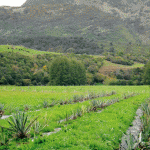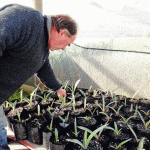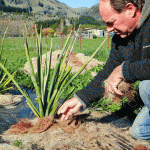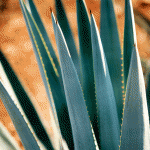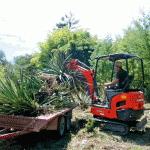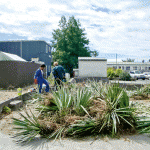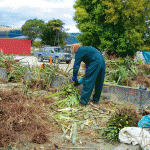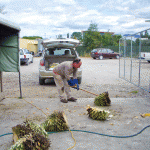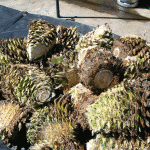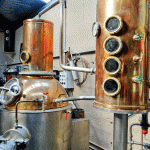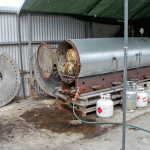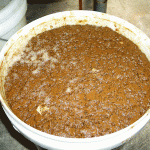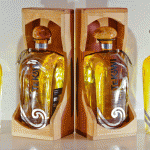How to grow tequila in New Zealand
- The site of an old vineyard is now growing the specialist agave plants required for making tequila.
- Plants are grown from tissue cultures, then sent to Golden Bay where Terry hardens them off in a tunnel house over a year.
- The plants are very low maintenance- a little mulch to stop grass competing with the roots, and a little fertiliser once a year.
- The plants really do want to hurt you says Terry- the red spine is like steel and every part of the plant has tiny hooks down its edges.
- Harvesting is done by digger to avoid injuries.
- The plants have to be chopped up to get to their ‘heart’.
- Chainsaws are the easiest method of leaf removal.
- The ‘hearts’ ready to be cooked.
- One of Terry’s distillation units which produces tequila, rum and whiskey.
- The hearts are cooked in a steam oven.
- The pulp is cooked up into a mash, brewed, then distilled.
- Terry can’t stop creating new products including a sugar-free health drink tequila.
The plants really want to hurt you, the harvest is carried out by digger, then chainsaw, you cook the heart out of it for three days, but the end result is worth toasting.
Words: Nadene Hall Images: Jane Bellerby
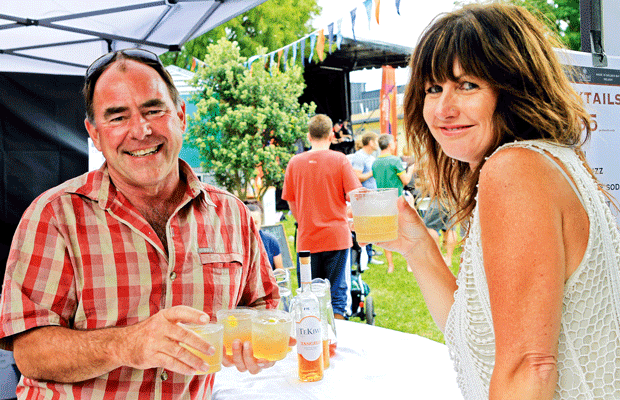
You’d normally find these blue agave on Mexican mountain plateaus, hundreds of metres above sea level, growing in sandy desert soils. The ones planted in the grassy fields of an old vineyard at sea level in Golden Bay are definitely out of their comfort zone, but they’re still producing a smooth 40% alcohol tequila.
Legally speaking, the drink Terry Knight and Rachel Raine are producing at Schnapp Dragon Village Distillery isn’t ‘Tequila’ – that term is owned by the Mexican government and the drink has protected designation of origin status – so this New Zealand first is formally known as TeKiwi 100% Blue Agave spirit.
“The Mexican government owns the word ‘Tequila’ outright so you can’t plagiarise it in any way or make a name that sounds like it, all of those things, but it’s also protected because it’s Mexico’s national drink.”
Growing his own tequila is the culmination of a long-held ambition by Terry and a good mate.
“A dear old friend of mine imported the seeds about 16 years ago. Before he died, I made a pact that I’d make this actually happen, so I talked to his widow and we ended up purchasing all the plants from her. Since then I’ve been nurturing them and propagating them and growing them and now we’re at the beginning stages of planting 20 acres out.”
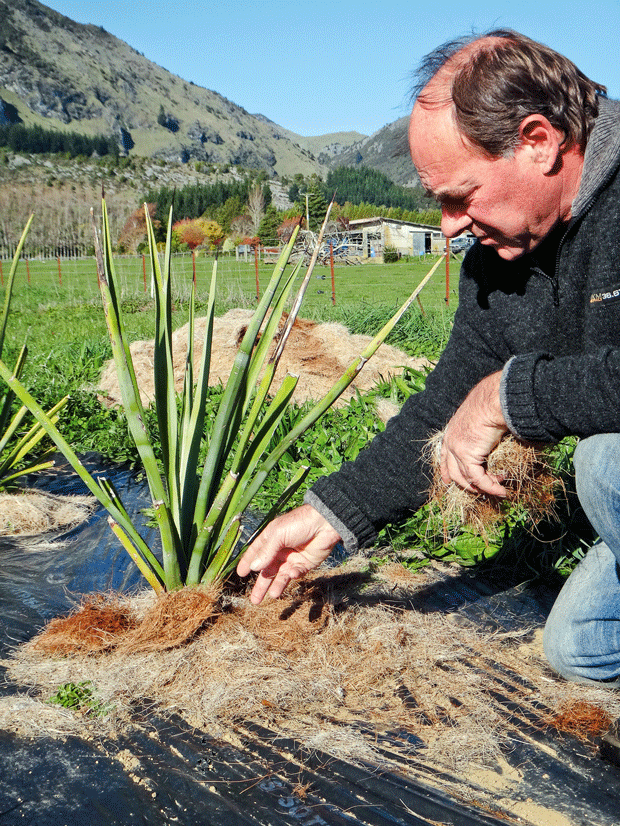
The plants are very low maintenance- a little mulch to stop grass competing with the roots, and a little fertiliser once a year.
The specific agave in question – Agave tequilana or Weber’s blue agave – isn’t something you’ll find at your local nursery. Terry started with his friend’s original plantation, and imported a replacement seed line. “There’s a world ban now in trading of both the plants or seeds… that’s why you haven’t got tequila plants all over the world. What we’ve pulled off here, we’re the first ever to achieve commercial production.”
Terry and Rachel’s initial run of just 300 bottles went on sale in September, a drop in the ocean compared to the 96 million cases of tequila sold by liquor companies worldwide every year. Growing tequila is hard work too, as almost everything is done by hand. The first step a few years ago was to recreate a hot, dry Mexican summer so they could germinate the seeds.
“We had to emulate a summer in Mexico by putting them in the oven at 40°C, it sort-of cracks them like a gorse seed,” says Terry. “You know how a gorse seed loves to go through fire, then sprout?Tequila seeds are quite similar.” These days things are a little easier, with lab-grown tissue cultures used to create the 3000 seedlings a year required to plant out 0.8ha (two acres) a year. Terry hardens them off in a glasshouse for a year before they are ready to plant out.
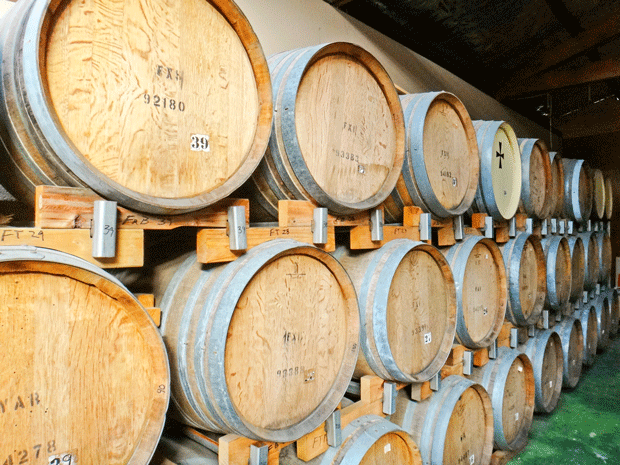
“Each year we plant two acres and that’ll give us a return of around about 15,000 one-litre bottles a year of tequila.” But it isn’t an easy job and it takes time. Imagine a flax that’s extremely rigid, grows up to about 1.8m tall over six to eight years, and forms a pineapple-shaped ‘heart’ at its centre which can weigh up to 40kg. Oh, and it really wants to hurt you, which has led the couple to a unique harvesting process.
“You should see the prickles,” says Terry. “We harvest the plant with a small excavator due to the nastiness of the prickles on the plant. They have a two inch (5cm) steel-type of prickle on the end, then they have little hook prickles all the way down the sides of the leaves and hook prickles on the back of them, and the two inch one on the end would go into your bone. They are evil, but we love them really.” “You treat them with respect!” laughs Rachel.
You haven’t worked with tequila until you get a prickle injury, and with the hands-on nature of the harvest, it’s inevitable says Terry. “They feel like they’re going to get infected but they don’t, they just have this ache for about 24 hours where they just throb. Like someone bruised your bone, you get that sort of feeling.”
The harvesting process destroys the plant, which is why the couple have started a rolling planting regime which will eventually cover 6.5ha (16 acres). Caring for the plants is easy – a spoonful of fertiliser each year, weeding, mulching, no water required – but turning them into tequila is an arduous process. Terry uses a chainsaw to cut off the rigid, prickly leaves to reveal the fibrous ‘heart’ of the plant. The hearts are then steam-cooked for three days.
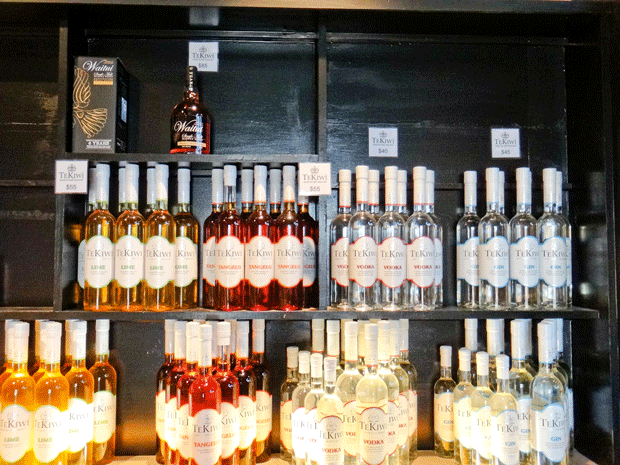
“Then we crush it, mulch it up – I put it through the garden mulcher – then from there it goes into a wringer washing machine, then we use the wringer part to break down the fibres, then we run it through the mangle to get the juice out.”
The juice is brewed into a type of beer (known as a mash), the mash is brewed again, then goes through a distillation process. The result: tequila, 40% alcohol by volume. “It’s a sipping tequila,” says Rachel. “You don’t need the lime, you don’t need the salt, you sip it straight, it’s that clean and gentle.”
That’s quite different to the tequila you’ll commonly see on sale at your local bottle store says Terry, where you need to add lime and salt to make it more palatable. The quality of their drink is down to three key factors. “It’s grown in different soil, it’s grown in a different environment, there’s just a whole lot of elements here that don’t exist in Mexico,” says Terry. “We’re growing them in beautiful loamy soils; they’re growing in volcanic soils. They get very, very cold up on those plateaus in winter, they also get torrential rain at times. We’re growing it close to the sea, and we’re on an island.”
Another factor is the water quality, direct from subterranean aquifers that feed Golden Bay’s world-famous Te Waikoropupū or ‘pu pu’ spring. “The joke is (Mexico) make tequila because you can’t drink the water,” says Terry. “Here, the soil, the water, the air… we have elements of flavour like a grape or a wine (because) our tequila picks up the terroir of our land and that terroir is then transferred into flavour, so the soil flavours come through, the general environment flavours are just part of it.”
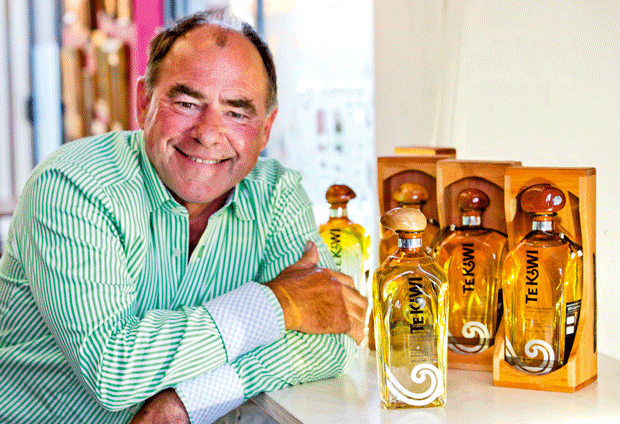
The tequila is just one of the spirits Terry and Rachel make from local produce. There are lime and tangelo liqueurs made from fresh fruit that would otherwise be left to rot on the ground, all juiced on site by Rachel, then distilled into a popular spirit by Terry and Sue Bensimon, New Zealand’s first qualified female distiller. There is also a gin made from native botanicals (kahikatea and totara), home-grown angelica root, orange blossom and juniper berries.
“It’s been a fantastic learning curve, lots and lots of things to learn and very few people to tell you what to do,” says Terry. “Distilling is a very secret business, no-one tells you the recipes, no-one really wants to share processes, it’s not like brewing or winemaking which is reasonably common knowledge. Distilling is a very refined art, it’s taking a palatable wine or a beer and turning it into something else.”
The couple have modelled their business on boutique operations they’ve seen in Europe.
“You see these little distilleries that make plum wine because the region grows plums,” says Terry. “Then you go two kilometres down the road and they grow cherries so they make cherry wine or kirsch. You go to another place and they’ve made schnapps from all the fruits of the region. “It intrigued me that this village concept of distilling was a way of using up fruit that was getting wasted. There’s a lot of fruit wasted in Nelson falling on the ground… at that time there were six tonnes of tangelo falling on the ground in one orchard. The model of the small village in Europe showed us a vision of what could be done.”
The couple sell their products in a few specialist liqueur stores, at the Nelson Markets, and from the Schnapp Dragon distillery’s cellar door in Golden Bay, mostly in a very short window says Rachel.
“Our high season is the nine weeks over summer here. You can get up to 30,000 people who descend on Golden Bay – it’s the summer trade we really focus on.”
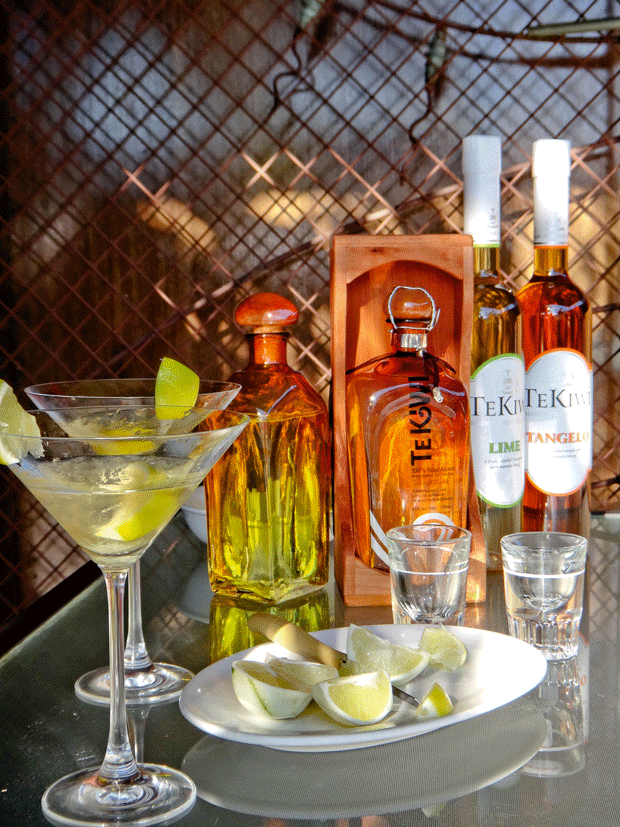
The rest of the year it’s mostly just hands-on hard work. “I’m juicing at the moment,” says Rachel. “So I source local produce, like our tangelos are sourced up the One Spec (a local valley). For a while we were using Bay Subtropical which is certified organic here in Golden Bay, we work with limes and tangelos which are our two liqueurs, and then through the year we do small runs of aguta which is the small baby kiwifruit, we get black currants which we turn into a spirit or a schnapps of some sort, it’s constantly experimenting and perfecting what Terry does.
“We spent last year in Germany and we were surprised and delighted at how local fruits are extracted, and people add value to wasted fruit. We really make use of fruit we do have.” Their latest new product is a sugar-free wild manuka tonic which includes root ginger, cayenne pepper, citrus, and apple cider vinegar. It started as one of Terry’s many experiments.
“I was trying to blanch pears to make spicy pears in a jar and it ended up tasting so good, I mixed it with hot water, then with soda. That was about three years ago and we’ve quietly been building it up.”
The Schnapp Dragon team is just three people, and while their boutique size and range is one of the things Terry and Rachel love about their business, it does mean a lot of hard work.
“So far as working hard and making a world-class product, it does have its challenges, and we’re educating New Zealanders as well,” says Terry. “It would be nice to stand alongside the craft brewery renaissance at the moment, the boutique spirit world is a bit of a small market here compared to Australia. Australia is big.”
HOW TO START A SUCCESSFUL DISTILLERY
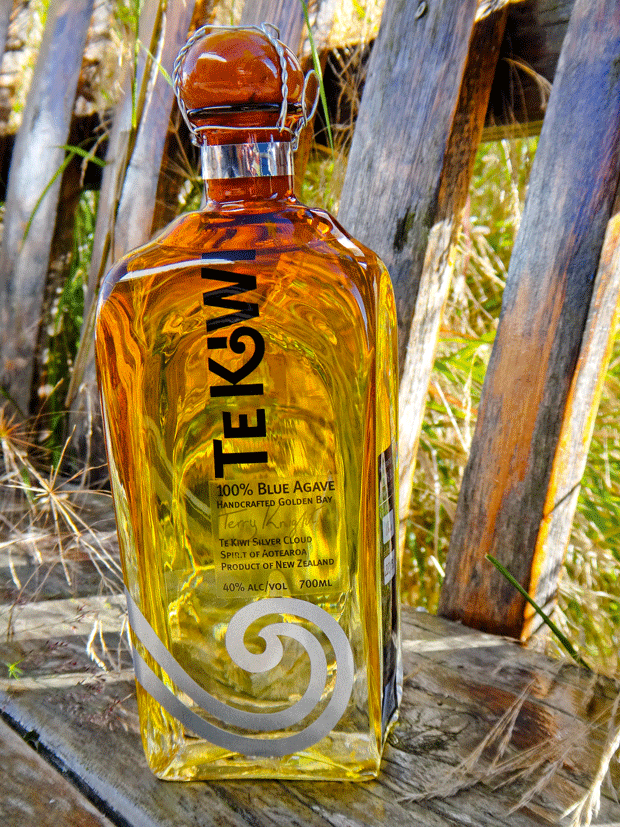
Terry’s route to master distiller started after he sold his popular eco-lodge, set in the bush of Abel Tasman National Park. “I was a lonely alcoholic in the forest with no friends!” he jokes. “I had a little stint after selling the lodge where I went and sold bread for a local bakery because I wanted something to do but within a week I could see it was a loser’s game.
“I thought, what can you make that gets better with age, tastes great, is fun, and it’s money in the bank? Like keeping your finances liquid in many ways. There was no-one making whiskey in New Zealand then, and what we’re doing now is trying to make a New Zealand-icon whiskey.”
But starting a distillery, even a small one, is a scary and expensive business. “It’s a very difficult business to get into, you’ve got to sit and wait for four years when you start to age stuff. You’re taking a minimum of a year just to make a good liqueur, that’s the inhibiting part for most people. “You also need a minimum of about $500,000 because the cost of your basic still is hitting on $150,000, so it’s inhibiting to get into because of the cost, but also because of the time it takes to get your products off the ground.
“Starting up is very difficult, so I say ‘no fear of failure’ or you won’t do it.”His first idea was to make a champagne out of honey, a drink he loved but which turned out to be too much of a hard sell
to Kiwi palates, uneducated about honey-based drinks.“I realised there was no use beating my head against the wall about the champagne, I’d be there forever trying to educate people and I learnt very quickly if you have to educate people about it, you’ll be educating every second person and it’s just hard work, whereas if you make a gin they know what gin is, if you make a rum they know what rum is, so I went back to basics.
“I don’t dwell on failure – if something’s not working we move onto the next thing quickly. I make a joke about ‘no fear of failure’, but I plan really well too.” That planning starts with basic research on how to make a drink and what the competition is, then Terry does a small run to see if he can make something palatable. If it is, it’s then sent to the Cawthron Institute laboratory to check for safety, before undergoing taste testing by a panel so secret, its members don’t know they’re on it.
“We check it on a couple of likely souls that visit, and normally I’ll sit on something for three months and try it out with the locals before we branch too far out with it, I have a testing panel I suppose… they don’t know they’re part of it! “You then spend $5000 with a designer, another $5000 for printing, a couple of thousand on bottles and $20,000 later you’ve got a product on the shelf.
“I don’t jump into a new product lightly but if I do it’s with full faith and no fear because fear holds us back in so many things in life, a lot of people fear success.” Terry has run experiments using all kinds of fruits, a few which have become the company’s success stories, with restaurants and customers buying it up from all over New Zealand. If you buy direct from the Schnapp Dragon stall at the Nelson Market or the cellar door, any customer can buy it at wholesale price.
Any experiments which don’t find favour don’t go to waste though. “I’ve got cranberry liqueur, 500 litres of it, I’ve got apricot liqueur, aguta (baby kiwifruit) liqueur, but they’re not commercial runs, all they were was just me feeling out ‘will this work?’ In my old age I plan to sip my way slowly through these litres of experiments with friends.”
Love this story? Subscribe now!
 This article first appeared in NZ Lifestyle Block Magazine.
This article first appeared in NZ Lifestyle Block Magazine.
